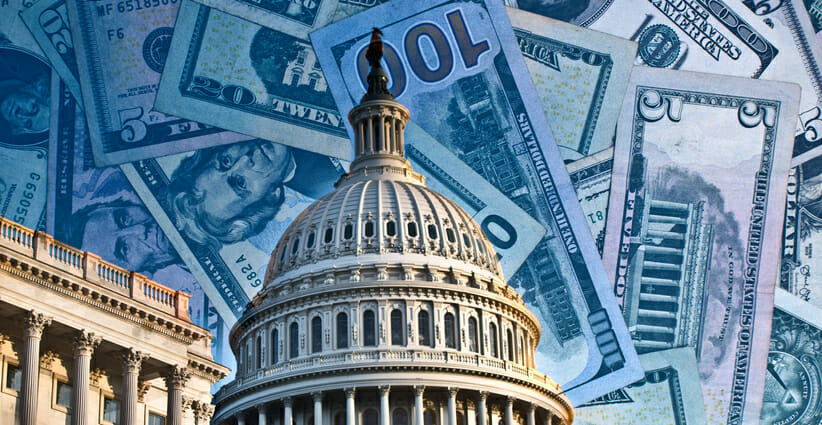
The $1.2 trillion Infrastructure Investment and Jobs Act was signed into law on November 15. This is the first part of President Joe Biden’s infrastructure plan, which combined with the $1.85 trillion Build Back Better Act, will call on Congress to invest almost $3 trillion in national infrastructure and social programs. Let’s break down what’s inside the bill and what it could mean for you.
The infrastructure bill calls on Congress to invest $1.2 trillion in seven major infrastructure areas. Below we break down the budget and goals for each, and group smaller programs into an additional category. Budget and goals are based on the White House fact sheet released on July 28:
Roads and Bridges. The White House says that one in five miles (173,000 miles of highways and major roads and 45,000 bridges) are in “poor condition.” The infrastructure bill proposes investing $110 billion in bridge and road repairs. These projects will focus on mitigating climate change, resilience, equity and safety for drivers, pedestrians and cyclists.
The proposal specifically includes $40 billion for bridge repair, replacement and rehabilitation; and $16 billion from this budget will be invested in other major projects.
Transit and Rail. The infrastructure bill proposes investing $105 billion in public transit and passenger and freight rail systems. The White House says public transit faces a multibillion dollar repair backlog, with more than 24,000 buses, 5,000 rail cars, 200 stations and thousands of track miles, signals and power systems in need of replacements.
Specifically, the deal will spend $39 billion on new investments to modernize transit, improve accessibility for elderly and people with disabilities, repair and modernize bus and rail fleets, provide greater station accessibility for all users and extend transit service to new communities.
The bill will also invest a total of $66 billion from this budget in rail to catch up on Amtrak maintenance backlog ($22 billion), upgrade the northeast corridor ($24 billion) and bring quality services to communities outside of the northeast and mid-Atlantic through intercity rail service grants ($12 billion), rail improvement and safety grants ($5 billion) and grade crossing safety improvements ($3 billion).
Upgrade Power Systems. The infrastructure bill proposes investing $73 billion to upgrade power infrastructure and build thousands of miles of new and resilient transmission lines that can facilitate the expansion of renewable energy.
High-Speed Internet. The White House says that 30 million Americans live in areas that do not have adequate broadband infrastructure. And the bill proposes investing $65 billion to ensure that access to high-speed internet is available nationwide.
The bill also aims to close the digital divide by lowering internet service prices. Goals include funding recipients to offer low-cost affordable plans, create price transparency and boost competition, among other initiatives.
Clean Drinking Water. The infrastructure bill invests $55 billion to deliver clean drinking water to 10 million American families and over 400,000 schools and child care facilities in rural towns and cities, including Tribal Nations and disadvantaged communities.
Funding will also replace lead pipes and service lines, in addition to the dangerous chemical PFAS (per- and polyfluoralkyl).
Invest in Resilience. The White House says that the U.S. faced almost $100 billion in climate disaster losses in 2020. The infrastructure deal proposes investing $50 billion in weatherization projects that aim to protect against droughts and floods, and prepare infrastructure for other climate changes, as well as extreme weather conditions and cyber attacks.
Airports, Ports and Waterways. The infrastructure bill proposes investing a total of $42 billion in repairing, maintaining and modernizing nationwide airports, ports and waterways. Specifically, legislation will spend $25 billion in airports and $17 billion in ports and waterways to make repairs and catch up on airport maintenance backlogs, reduce congestion and emissions, and upgrade with electric and other low-carbon technologies.
Additional Programs. Legislators have also proposed investing an additional $38 billion in environmental remediation ($21 billion), safety ($11 billion), electric vehicle infrastructure ($7.5 billion), electric buses and transit ($7.5 billion) and reconnection communities ($1 billion).
What Was Left Out of the $2.3 American Jobs Plan?

The initial American Jobs Plan called on Congress to invest $2.3 trillion (approximately 1% of the U.S. GDP annually) on clean-energy, electric vehicles, high-speed internet, and workplace development programs, among other physical and human infrastructure investments.
More than half of that plan targeted transportation, elderly and disabled care, and manufacturing, which added up to $1.321 trillion. It invested specifically $213 billion in housing; $180 billion in tech research and development; $311 billion in water, clean-energy and internet systems; $100 billion in schools and child care centers and $100 billion in workforce training over eight years.
The new infrastructure bill notably excludes $400 billion for elderly and disabled care, which proposed expanding access to long-term care services under Medicaid and creating infrastructure for well-paying caregiving jobs.
The bill also leaves out $100 billion for workplace development, which proposed creating a new Dislocated Workers Program and sector-based training ($40 billion), and targeted workforce development opportunities for underserved communities ($17 billion).
Biden’s initial plan also called for increasing the capacity of existing workforce development and worker protection systems ($48 billion).
How Will Congress Pay for the Infrastructure Bill?

The Congressional Budget Office said on August 1 that the infrastructure bill will add $256 billion to the national deficit from 2021 to 2031. The report also estimates that the infrastructure bill will “decrease direct spending by $110 billion, increase revenues by $50 billion and increase discretionary spending by $415 billion.”
In order to pay for the infrastructure bill, Democratic legislators initially proposed raising taxes. These included rolling back President Trump’s 2017 corporate tax reduction (currently set at 21%) and increasing it to 28%.
The White House also wanted to raise the global minimum tax on U.S. corporations from 10.5% to 21%, and apply a 15% minimum tax on book income (this is the income used to report profits for investors) for large corporations.
In addition to corporate tax hikes, Biden supports raising the top individual income rate from 37% to 39.6% for incomes above $400,000 and double the capital gains tax from 20% to 39.6% for investment gains over $1 million.
The White House fact sheet from July 28 says that infrastructure legislation will be financed through “revenue generated from higher economic growth as a result of the investments” and a combination of bipartisan measures that include:
- Redirecting unspent emergency relief funds
- Targeted corporate user fees
- Strengthening tax enforcement (with a focus on crypto currencies)
How the Infrastructure Bill Passed in the House
House Republicans joined Democrats to pass the $1.2 trillion infrastructure bill with a 228 to 206 vote on November 5. Progressive Democrats delayed voting on the bipartisan legislation until Congress agreed to move the $1.85 trillion Build Back Better Act forward.
This infrastructure legislation had also pitted moderate Democrats against progressives, who asked for a nonpartisan cost estimate score on the $1.85 trillion Build Back Better Act. Though moderates ultimately pledged to support the social spending legislation as long as it doesn’t add to the deficit.
The speaker initially imposed a September 30 deadline to pass the $1.2 trillion bipartisan bill, which was when the extension for the Surface Transportation Reauthorization Act was set to expire. But Democrats failed to meet this self-imposed deadline after progressives and moderates could not reach an agreement.
House Speaker Nancy Pelosi (D-CA) then announced a new October 31 deadline in a letter to colleagues after a 30-day extension was passed for the Surface Transportation Reauthorization Act.
For the final House vote on November 5, 13 Republicans crossed party lines to support the bill, while six progressive Democrats voted against it.
How Was the Infrastructure Bill Passed in the Senate?
Nineteen Republican Senators joined Democrats on August 10 to pass the $1.2 trillion bipartisan infrastructure bill with a 69 to 30 vote. The 2,702-page bill was introduced in the chamber on August 1, and it combines $550 billion in new spending from the bipartisan deal with previously approved funds for a total of $1.2 trillion.
Initially, seventeen Senators joined Democrats in a 67 to 32 vote to open the debate process for the infrastructure bill on July 28. The Senate must obtain at least 60 votes to close the process and advance legislation for final approval. One Senator did not vote and two Republicans switched sides to support the bill in the final vote.
For reference, data from SmartAsset’s 2021 study on the best states with infrastructure shows that five midwestern states rank in the top 10. Kansas, Minnesota, Nebraska, North Dakota and Wisconsin lead with more than 94% of bridges and 83% of roads in good or fair condition. Additionally, power outages are relatively uncommon in all five states.
Senate legislators in those five midwestern states were divided on the final vote for the bipartisan bill. Senators John Hoeven (R-ND), Kevin Cramer (R-ND), Tammy Baldwin (D-WI), Amy Klobuchar (D-MN), Tina Smith (D-MN) and Deb Fischer (R-NE) voted in favor. While Senators Ben Sasse (R-NE), Ron Johnson (R-WI), Jerry Moran (R-KS) and Roger Marshall (R-KS) voted against it.
Delaware, Maryland, Nevada, Oregon and Utah round out the top 10 in SmartAsset’s study. And Senator Mike Lee (R-UT) was the only legislator out of all 10 in those five states to vote against the new bipartisan deal.
For states with the most infrastructure needs at the bottom of the 2021 study (these include Louisiana, Michigan, Mississippi, Oklahoma and West Virginia), Senators were mostly divided along party lines in favor and against it. You should note, however, that Republican Senators Bill Cassidy (R-LA) and Roger Wicker (R-MS) supported the bill.
To see how your Senator voted on August 10, the Senate roll call is broken down alphabetically by state in the table below. The votes of the nineteen Republicans who supported the final vote for the bipartisan bill are highlighted in bold.
August 10 Final Senate Vote: Passed 69 to 30
State |
Senator |
Vote |
Senator |
Vote |
| Alabama | Shelby (R-AL) | No | Tuberville (R-AL) | No |
| Alaska | Murkowski (R-AK) | Yes | Sullivan (R-AK) | Yes |
| Arizona | Kelly (D-AZ) | Yes | Sinema (D-AZ) | Yes |
| Arkansas | Boozman (R-AR) | No | Cotton (R-AR) | No |
| California | Feinstein (D-CA) | Yes | Padilla (D-CA) | Yes |
| Colorado | Bennet (D-CO) | Yes | Hickenlooper (D-CO) | Yes |
| Connecticut | Blumenthal (D-CT) | Yes | Murphy (D-CT) | Yes |
| Delaware | Carper (D-DE) | Yes | Coons (D-DE) | Yes |
| Florida | Rubio (R-FL) | No | Scott (R-FL) | No |
| Georgia | Ossoff (D-GA) | Yes | Warnock (D-GA) | Yes |
| Hawaii | Hirono (D-HI) | Yes |
Schatz (D-HI)
| Yes |
| Idaho | Crapo (R-ID) | Yes | Risch (R-ID) | Yes |
| Illinois | Duckworth (D-IL) | Yes | Durbin (D-IL) | Yes |
| Indiana | Braun (R-IN) | No | Young (R-IN) | No |
| Iowa | Ernst (R-IA) | No | Grassley (R-IA) | Yes |
| Kansas | Marshall (R-KS) | No | Moran (R-KS) | No |
| Kentucky | McConnell (R-KY) | Yes | Paul (R-KY) | No |
| Louisiana | Cassidy (R-LA) | Yes | Kennedy (R-LA) | No |
| Maine | Collins (R-ME) | Yes | King (I-ME) | Yes |
| Maryland | Cardin (D-MD) | Yes | Van Hollen (D-MD) | Yes |
| Massachusetts | Markey (D-MA) | Yes | Warren (D-MA) | Yes |
| Michigan | Peters (D-MI) | Yes | Stabenow (D-MI) | Yes |
| Minnesota | Klobuchar (D-MN) | Yes | Smith (D-MN) | Yes |
| Mississippi | Hyde-Smith (R-MS) | No | Wicker (R-MS) | Yes |
| Missouri | Blunt (R-MO) | Yes | Hawley (R-MO) | No |
| Montana | Daines (R-MT) | No | Tester (D-MT) | Yes |
| Nebraska | Fischer (R-NE) | Yes | Sasse (R-NE) | No |
| Nevada | Cortez Masto (D-NV) | Yes | Rosen (D-NV) | Yes |
| New Hampshire | Hassan (D-NH) | Yes |
Shaheen (D-NH)
| Yes |
| New Jersey | Booker (D-NJ) | Yes | Menendez (D-NJ) | Yes |
| New Mexico | Heinrich (D-NM) | Yes | Lujan (D-NM) | Yes |
| New York | Gillibrand (D-NY) | Yes | Schumer (D-NY) | Yes |
| North Carolina | Burr (R-NC) | Yes | Tillis (R-NC) | Yes |
| North Dakota | Cramer (R-ND) | Yes | Hoeven (R-ND) | Yes |
| Ohio | Brown (D-OH) | Yes | Portman (R-OH) | Yes |
| Oklahoma | Inhofe (R-OK) | No | Lankford (R-OK) | No |
| Oregon | Merkley (D-OR) | Yes | Wyden (D-OR) | Yes |
| Pennsylvania | Casey (D-PA) | Yes | Toomey (R-PA) | No |
| Rhode Island | Reed (D-RI) | Yes | Whitehouse (D-RI) | Yes |
| South Carolina | Graham (R-SC) | Yes | Scott (R-SC) | No |
| South Dakota | Rounds (R-SD) | Did Not Vote | Thune (R-SD) | No |
| Tennessee | Blackburn (R-TN) | No | Hagerty (R-TN) | No |
| Texas | Cornyn (R-TX) | No | Cruz (R-TX) | No |
| Utah | Lee (R-UT) | No | Romney (R-UT) | Yes |
| Vermont | Leahy (D-VT) | Yes |
Sanders (I-VT)
| Yes |
| Virginia | Kaine (D-VA) | Yes | Warner (D-VA) | Yes |
| Washington | Cantwell (D-WA) | Yes | Murray (D-WA) | Yes |
| West Virginia | Capito (R-WV) | Yes | Manchin (D-WV) | Yes |
| Wisconsin | Baldwin (D-WI) | Yes | Johnson (R-WI) | No |
| Wyoming | Barrasso (R-WY) | No | Lummis (R-WY) | No |
Bottom Line
Biden signed the $1.2 trillion infrastructure bill into law on November 15. The legislation supports investments in roads, water, electricity, broadband internet and other physical infrastructure projects. This opens the process for lawmakers in the chamber to vote on the $1.85 trillion Build Back Better Act, which will push beyond physical infrastructure projects to fund education, climate and social programs.
Tips to Invest in Infrastructure
- The infrastructure bill will create new investing opportunities. SmartAsset’s investment guides will help you learn more about municipal bonds, and infrastructure and utility funds.
- A financial advisor can help you identify other infrastructure investment opportunities and create a financial plan to reach your goals. SmartAsset’s free tool matches you with up to three financial advisors in your area, and you can interview your advisor matches at no cost to decide which one is right for you. If you’re ready to find an advisor who can help you achieve your financial goals, get started now.
Photo credit: iStock.com/kali9, iStock.com/LSOphoto, iStock.com/Douglas Rissing